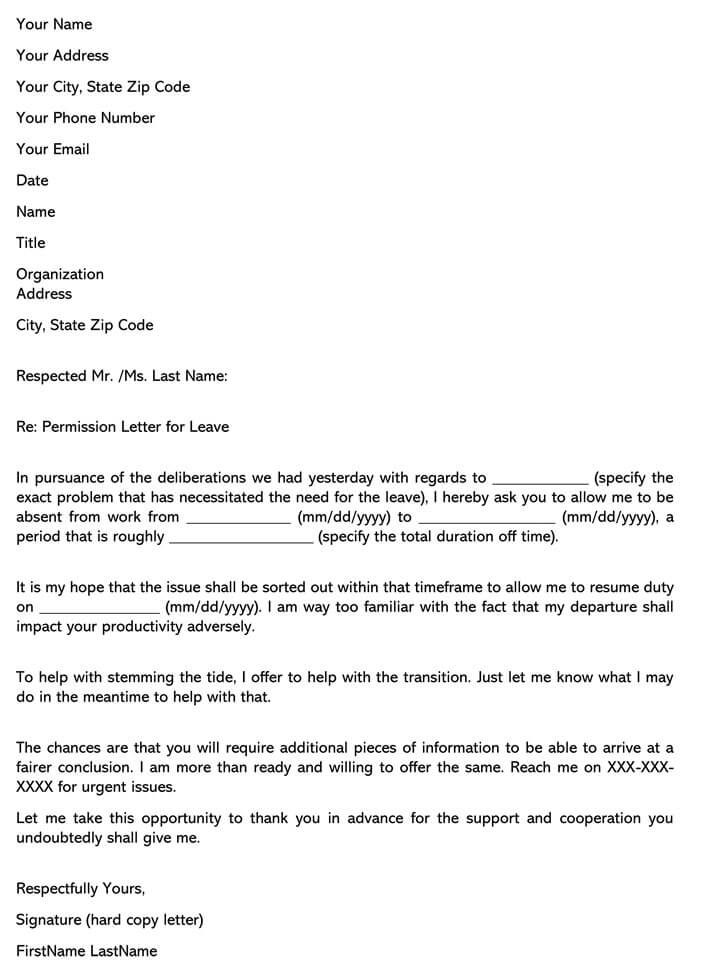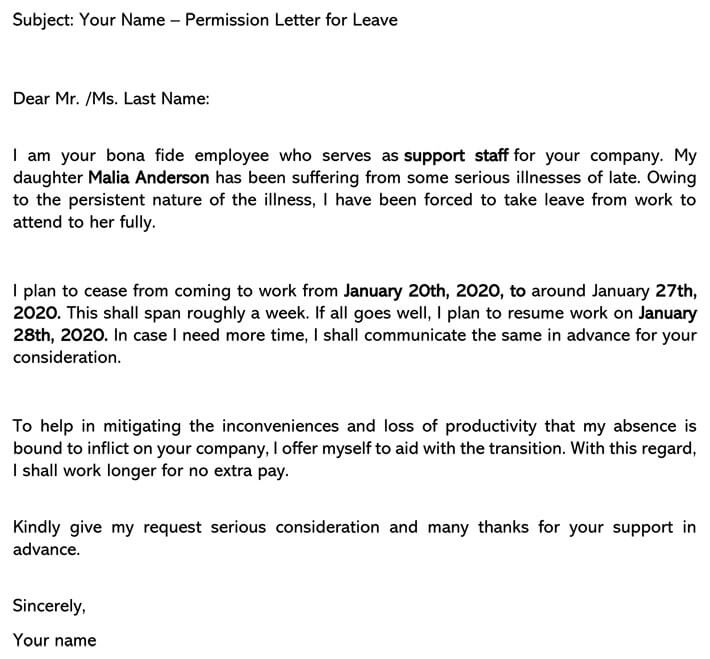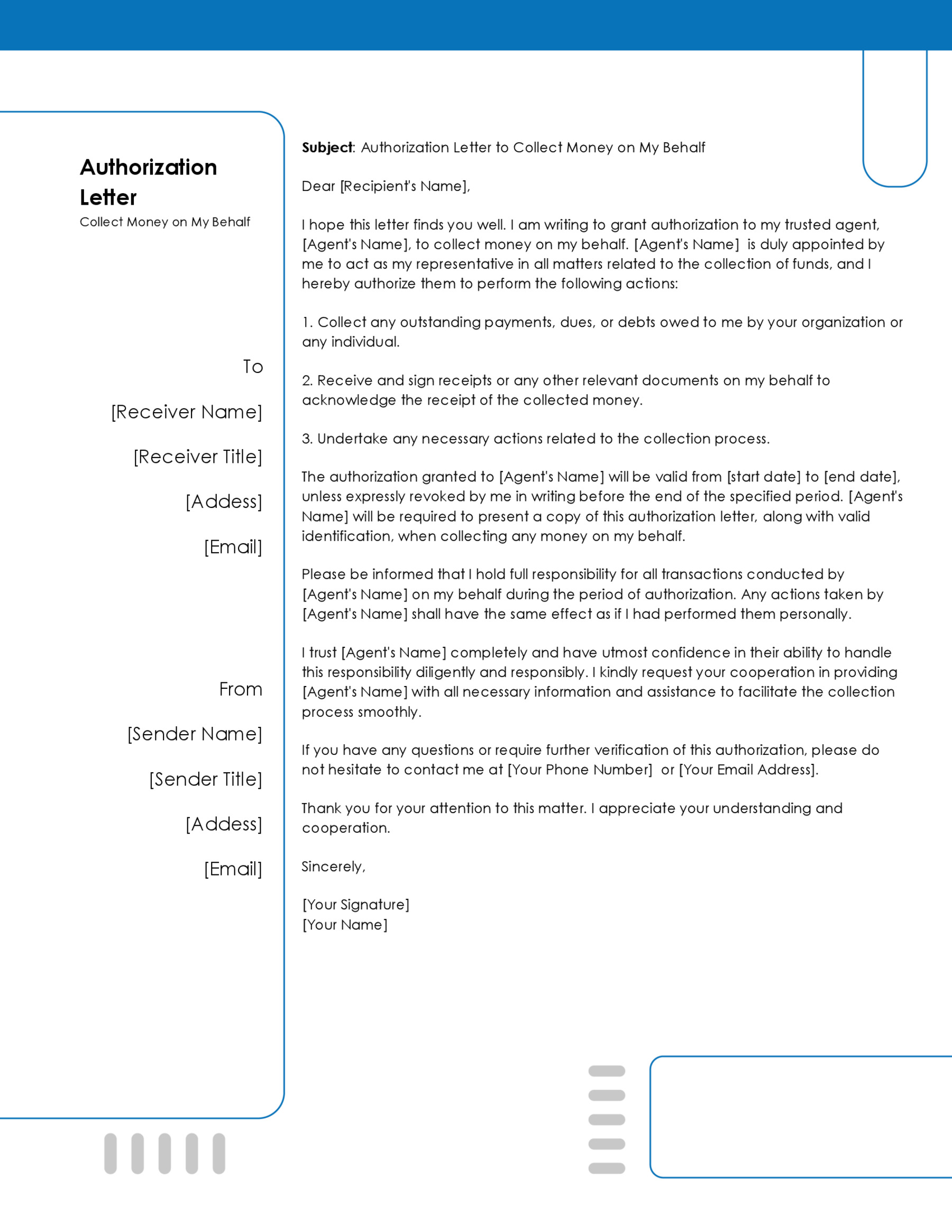A letter of permission is written by an employee to their supervisor, manager, or employer to request leave from work for a specified period due to personal reasons.
In a typical workplace, there are instances when an employee requires time off for personal reasons, such as the death of a family member, a medical emergency, or a vacation. During such events, an employee has to obtain permission for leave from their employer, and a letter for leave is used to make such requests formal.
This section outlines the key benefits of having it in an employee’s personnel file:
- The letter provides a written record of the notice issued by an employee to the employer before taking a leave of absence. Thus, if the employee is later penalized for being away from work, it can be used as evidence against the employer.
- It explains why they are requesting time off. Explaining this reason in person might also work, as a written explanation makes it easier for the supervisor, human resource manager, or employer to understand the urgency of the matter. Therefore, they would be more willing to grant the employee leave from work.
- It can be forwarded to the company’s executives if the need arises, instead of relying on a supervisor to give an oral explanation of the situation- leading to distortion of the message. This helps maintain an employee’s standing in the organization and consequently minimizes the fallout in relation to the employee’s career.
- Laws such as the FMLA (Family and Medical Leave Act) and the ADA (Americans with Disabilities Act) dictate that eligible employees be given time off from work for personal reasons that meet the criteria specified in the Act. While on leave, the employee’s job must remain open, and their benefits, such as health insurance coverage, must be continued. If an employee’s job is compromised or their benefits are discontinued for taking leave from work, this letter can serve as sufficient evidence to sue the employer on the grounds of non-conformity with federal employment laws.
Free Permission Letter Templates
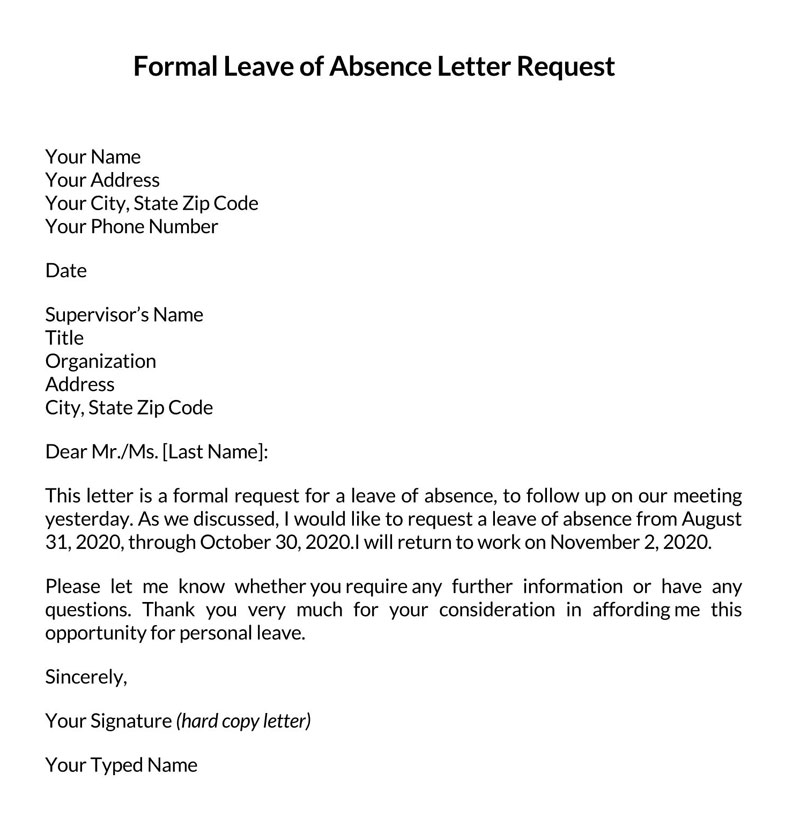
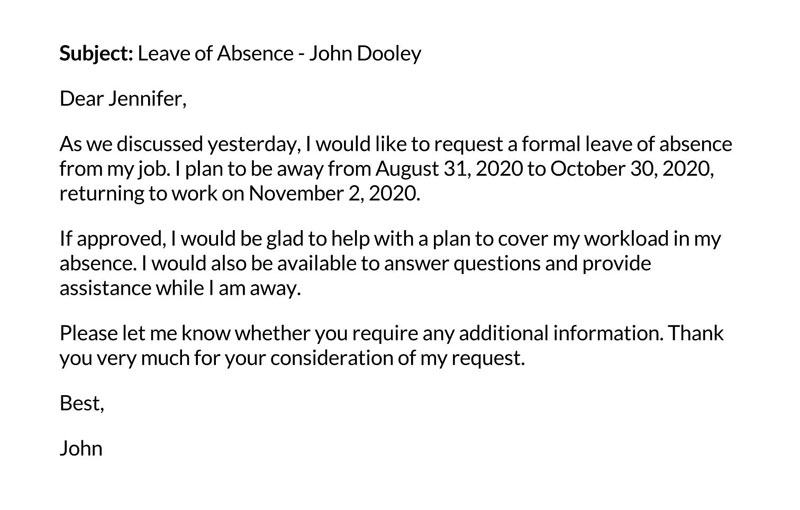
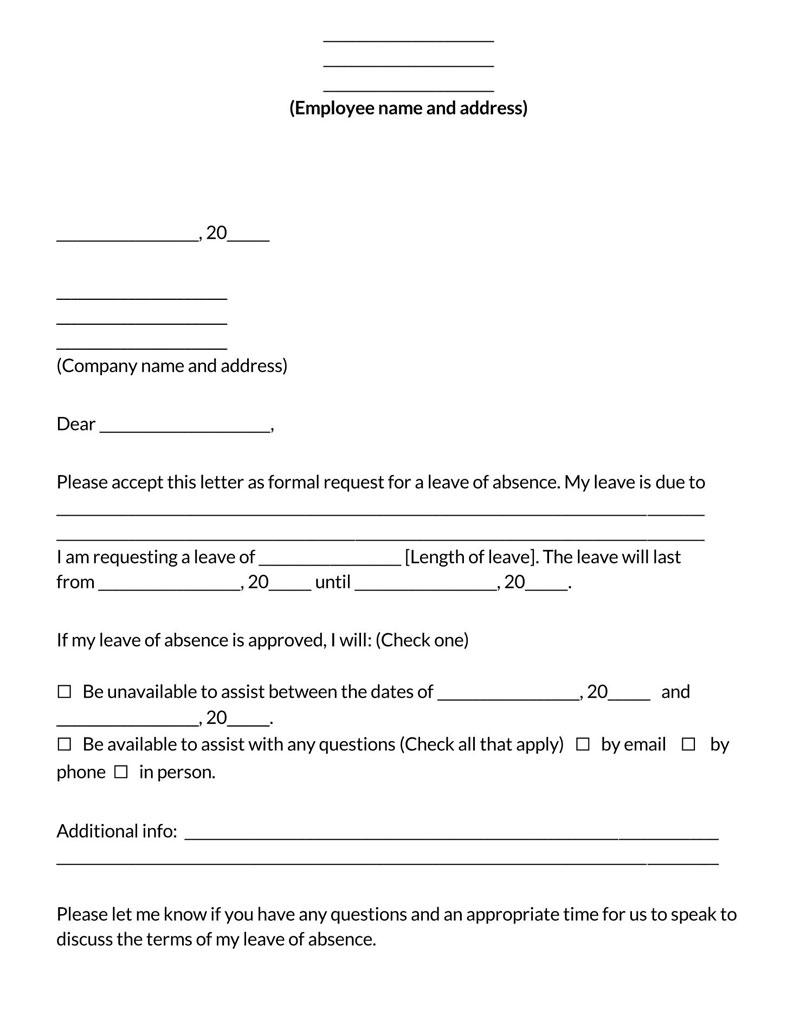
Reasons for Writing a Permission Letter of Leave
An employee may need to take time off work for several reasons, including personal or family-related reasons. Some of the reasons are protected by federal laws such as FMLA and ADA, and others are covered under company policies.
This section describes some of the common reasons why employees request leave from work using formal letters of permission:
Eligible reasons to take time off from work under the Family and Medical Leave Act include:
- Birth and care of a baby
- Adoption of a child
- To take care of an ailing immediate kin, for example, a sick spouse, child, or parent
- If an employee is sick with a severe health condition, such as surgery, trauma due to an accident, or mental health issues such as depression.
- The FMLA also allows eligible employees to take up to 26 weeks off from work to take care of a military service member with a severe injury or illness if the employee is a spouse, child, parent, or the next of kin to that service member.
note
Not every worker is eligible for job protection under the FMLA. Eligible employees are those who are working with companies/employers with 50 or more employees working within 75 miles of the office. Besides, those who qualify to take leave from work under this Act must have worked with the employer for at least a year before needing the time off. Moreover, they should have put in at least 1,250 hours of service to the organization.
Situations not protected by the FMLA or any other employment laws that may necessitate an employee to request leave from work include:
- Happy occasions that deserve to be celebrated with leave from work, such as taking a sabbatical, finishing graduate school, or taking an extended honeymoon with a spouse.
- An employee may request permission to be away from work to mourn a friend/ loved one’s death or make complete funeral arrangements for a relative.
What to Include in a Permission Letter for Leave
When crafting it for leave, there are essential details that the employee should include in the letter to help convince their supervisor or HR staff to grant them the leave of absence.
They include:
The employee’s personal information
It should include the personal information of an employee. Here, the employee should provide their full name as on the personnel file, their employment/payroll number, and their respective department name. One can also include an email address or a reliable mobile phone number to make it easier for the supervisor, manager, or HR staff to contact them.
The date
The date on which it is written should also be featured in the letter.
The manager/supervisor/HR staff’s information
In this section, the employee should write the recipient’s information, including their name, title in the organization, organization’s name, address, city, state, and zip code.
A formal greeting/salutation
Before writing the contents of the letter, the employee should write a formal greeting addressed directly to the manager or supervisor. This shows professionalism, and it makes the letter seem more personalized.
The reason for the request
The introductory paragraph of the letter should typically explain why the employee needs to take some time off from work. If the reason is a personal/family medical emergency, taking care of a newborn baby, caring for a military service member, or simply for a sabbatical, the employee should make sure to mention it.
The reference date
If an employee meets with their supervisor or manager and discusses their intention to take time off and attend to personal matters before the actual writing of this letter, then they should reference the date of the discussion in the letter’s body paragraph.
The proposed absence dates/affected dates
The proposed absence/affected dates refer to the exact dates that the employee intends to be away from work. These dates should be spelled out in the Day/Month/Year format to avoid any ambiguities. The total leave days should also be mentioned in the leave letter.
The planned return date
The employee must categorically state when they plan to return to work. Generally, this is usually on the last date of the leave, but in some cases, it is usually the first workday of the week after the last leave day, exempting weekends and public holidays.
note
Different companies may have different policies that stipulate eligible reasons for taking leave from work and the acceptable timeframe. For this reason, employees should check their employee handbook on leave-related policies to ensure they conform to company policies and avoid frustrations when superiors deny their leave requests.
An offer to aid with transition, if feasible
If possible, the employee can offer the employer some form of assistance to help them and their colleagues transition while they are on leave. This can be in the form of allocating some of their duties to a colleague to avoid piling more work on other workers or offering to work remotely from home. If the employee decides to include an offer of assistance to the employer, they should be specific about the exact nature of the assistance.
A thank-you note to the recipient of the letter
Including an advance thank-you note to the manager or supervisor for reading the letter and putting the request into consideration increases the chances of getting the leave request approved.
Other Considerations For the Employee Taking the Leave
Aside from submitting formal permission for a leave letter, using a proper business letter format, and including all the critical contents of an effective leave letter from work, there are other considerations that the employee should keep in mind to help convince managers and supervisors to let them take time off from work.
These considerations include:
Give as much notice as possible
Employees are advised to promptly inform employers of something happening in their lives that might eventually require them to ask for a leave, so an employer can plan and prepare for their absence. This way, when the time comes, they will most likely approve the leave request.
Understand the legal rights regarding time off
Before writing the letter for leave from work, employees should strive to understand their company policy on leave-related matters and what laws, such as the Family and Medical Leave Act or the Americans with Disabilities Act (ADA) dictate the time off. Understanding workplace rights and federal leave-related laws enables employees to approach the conversation knowledgeably and negotiate the best possible solution for themselves and their employers.
Develop an agreeable plan with the HR staff/supervisor
An employee who intends to take leave from work can consider working with their supervisor or manager to engineer a plan that works in favor of everyone. This may include working remotely from home for a few weeks while recovering from an injury or taking a voluntary leave of absence during the company’s off-season- (when the company is not too busy with work). However, in this case, employees are advised to keep a paper trail of FMLA-related documents and correspondence.
Plan a meeting with the supervisor or HR staff
Before crafting it, an employee can consider scheduling a meeting with the supervisor to explain their situation and verbally request a leave of absence. In this case, an employee should be patient and tactful and plan the meeting on a day when the boss is generally happy with how things are working out in the organization. This way, their leave request will find a more receptive audience.
Never provide any legal ultimatums
This letter should make the employer feel that they are in control and can allow them to take the leave out of goodwill. If necessary, the employee can invoke any legal protection later with the assistance of the HR department, but legal ultimatums should never appear in the first letter.
Consequences of Not Sending a Permission Letter for Leave
When planning to take an extended leave of absence, employees need to inform their supervisors, managers, or personnel staff in writing. The written document certifies that the employer has been informed about the employee’s intention to take some time off work. Without the letter, there is no record that the employee requested a leave of absence, and this can lead to drastic consequences.
These consequences include:
- Losing future vacation days and sick days, being demoted from work, or worse, getting a termination letter: Some companies have policies that dictate that employees will be penalized if they are away from work without formal written notice. Based on the employee’s current standing with the employer/their value in the organization, they may lose their sick/vacation leave, be demoted from their current position, or the employer may decide to fire them on the grounds of insubordination.
- If an employee verbally discusses their intention to be away from work with a supervisor, they are granted an extended leave of absence. Unfortunately, the supervisor fails to record it in the employee’s personnel file or notify other executives within the organization. As a result, the employee might be penalized once they return from their leave. In addition, it may lead to a fallout with the employer, which is bad for the employee’s career and time in the organization, as it may lead to a more drastic consequence such as employment termination.
Permission Letter for Leave from Work Template
Your Name
Your Address
Your City, State Zip Code
Your Phone Number
Your Email
Date
Name,
Title,
Organization,
Address,
City, State, Zip Code
Respected Mr. /Ms. Last Name:
Re: Permission Letter for Leave
In pursuance of the deliberations, we had yesterday with regards to ____________ (specify the exact problem that has necessitated the need for the leave), I hereby ask you to allow me to be absent from work from _____________ (mm/dd/yyyy) to _________________ (mm/dd/yyyy), a period that is roughly __________________ (specify the total duration of time).
It is my hope that the issue will be sorted out within that timeframe to allow me to resume duty on _______________ (mm/dd/yyyy). I am way too familiar with the fact that my departure shall impact your productivity.
To help with stemming the tide, I offer to help with the transition. Just let me know what I can do in the meantime to help with that.
The chances are that you will require additional pieces of information to be able to arrive at a fairer conclusion. I am more than ready and willing to offer the same. Reach me at XXX-XXX-XXXX for urgent issues.
Let me take this opportunity to thank you in advance for the support and cooperation you undoubtedly will give me.
Respectfully Yours,
Signature (hard copy letter)
FirstName LastName
Sample Leave Request Letter
Dear Mr. Jacob Smith,
I am writing to formally request a leave of absence from my position as Senior Analyst at Greenwood Enterprises for the period of July 5th to July 19th, 20XX. This leave is necessary due to a family emergency that requires my immediate attention.
I have ensured that all my current projects are at a stage where they can be easily handled by my colleagues in my absence, and I have briefed Ms. Emily Johnson about the specifics of my ongoing tasks. Furthermore, I am willing to provide any assistance remotely if urgently needed.
I understand the inconvenience that my absence may cause and I am committed to resuming my duties promptly on July 20th, 20XX. I am grateful for your understanding and support in this matter.
Thank you for considering my request. Please let me know if you need any further information or if there are any forms I should complete as part of this process.
Sincerely,
Michael Thompson
Senior Analyst
Marketing Department
Permission Letter for Leave (Email Example)
Subject: Application for Personal Leave – Olivia Martinez
Dear Ms. Linda Harris,
I hope you are doing well. I am writing to request a short leave of absence from my role as Project Coordinator at Orion Technologies. I would like to take this leave from August 12th to August 26th, 20XX.
The purpose of this leave is to address some pressing personal matters that require my full attention during this period. I believe attending to these matters now will allow me to return to work with a clearer focus and renewed energy.
To ensure a smooth transition, I have already discussed my workload with Mr. Alex Chen, who has agreed to oversee my projects during my absence. All necessary information and contacts have been shared with him. I will also ensure that all pending tasks are completed or at a stage where Alex can easily take over before my leave starts.
I understand the importance of my role and the potential impact of my absence. Therefore, I am committed to making this transition as seamless as possible and resuming my responsibilities promptly on August 27th, 20XX.
Please advise me if there are any formalities or further details required for processing my leave application.
Thank you very much for your understanding and support.
Kind regards,
Olivia Martinez
Project Coordinator
IT Solutions Division
Analysis
The leave request letter and email provided are excellent examples for readers looking to draft their own requests, as they embody several key aspects of effective professional communication. Firstly, they are written with a professional tone and clarity, ensuring the message is understood without ambiguity. The language used is respectful and polite, acknowledging the recipient’s position and the organizational hierarchy, which is crucial in a professional setting. The specific mention of the leave’s start and end dates is a critical detail, allowing for proper planning and showing that the writer has thoroughly considered their request. Additionally, the inclusion of a valid and understandable reason for the leave adds to the request’s legitimacy.
Another commendable aspect is the writer’s foresight in preparing for their absence by briefing a colleague on ongoing projects and demonstrating responsibility and consideration for the team’s workflow. The writers offer to provide assistance during the leave period, if urgently required, further illustrating their commitment and responsibility towards their duties. The expression of gratitude towards the manager for their understanding and consideration helps maintain a positive relationship, an essential element in any professional interaction.
Finally, the proper closure and provision of contact information ensure open lines of communication, reinforcing the writer’s professionalism and dedication to their role. These elements collectively serve as a comprehensive guide, emphasizing professionalism, clarity, responsibility, and respect, which are pivotal in workplace communications, especially when making requests that impact both the individual and the team.
Conclusion
Generally, employers are always more than willing to honor employee’s leave requests if they submit their requests professionally and considerately. In this regard, writing them a letter of permission for leave from work is considered an effective method. The employee formats their letter accordingly and provides a good enough reason for needing the time off. This article has covered everything that employees need to know about such letters and considerations to take when asking for leave from work to improve the chances of its approval.
